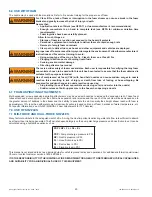
©Copyright Task Force Tips, Inc. 2002 - 2015
LIN-035 June 16, 2015 Rev15
26
11.3 SERVICE TESTING
In accordance with NFPA 1962 (2013), nozzles must be tested a minimum of annually. Nozzles failing any part of this test must be
removed from service, repaired and retested upon completion of the repair.
11.3.1 HYDROSTATIC TESTING
Each nozzle with a shut off mechanism shall be tested in the following manner.
1. The nozzle shall be placed in a device capable of holding it and the shut off shall be closed.
2. A device capable of exerting a hydrostatic pressure of 300 psi (2070 kPa) or 1.5 times the maximum operating pressure,
whichever is higher, shall be attached to the nozzle.
3. All air shall be bled from the system.
4. The gage pressure shall be increased by 50 psi (3.5 bar or 345 kPa) increments, held for 30 seconds at each pressure up to
the maximum pressure for which the nozzle is being tested, and then held for one minute without leakage.
5. There shall be no sign of leakage through the valve or shut off.
11.3.2 FLOW TESTING
Flow testing must be conducted in the following manner.
1. The nozzle shall be mounted so that the fl ow rate and pressure through the nozzle and the pressure at the inlet can be
accurately measured.
2. With the shut off fully open, the inlet pressure shall be adjusted to the rated pressure ±2 percent.
3. The valve or shut off and pattern controls shall be operated through their full range of motion at 100 psi (6.9 bar or 690 kPa)
with no signs of leaking, binding or other problems.
4. Evaluate the fl ow of nozzles as defi ned by NFPA 1964 in the following manner:
Automatic (Constant Pressure) Spray Nozzles
1. The fl ow rate shall slowly be increased to the maximum rated fl ow, and the minimum and maximum pressures through
the fl ow range recorded.
2. Nozzles shall maintain their rated pressure ±15 psi (±1 bar or ±100 kPa) throughout the rated fl ow range.
11.3.3 RECORDS
A record of testing and repairs must be maintained from the time the nozzle is purchased until it is discarded. Each TFT nozzle is
engraved with a unique serial number which, if so desired, can be used to identify nozzle for documentation purposes.
The following information, if applicable, must be included on the test record for each nozzle:
1. Assigned
identifi cation number
2. Manufacturer
3. Product or model designation
4. Vendor
5. Warranty
6. Hose connection size
7. Maximum operating pressure
8. Flow rate or range
9. Date received and date put in service
10. Date of each service test and service test results
11. Damage and repairs, including who made the repairs and the cost of repair parts
12. Reason removed from service
NFPA 1962: Standard for the care, use, inspection, service testing, and replacement of fi re hose, couplings, nozzles and fi re hose appliances. (2013
ed., Section 5.5.4). Quincy, MA: National Fire Protection Agency.



































